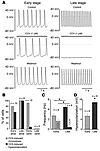Citations to this article
Citation Information: J Clin Invest. 2004;114(7):994-1001. https://doi.org/10.1172/JCI15925.
Abstract
Parasympathetic slowing of the heart rate is predominantly mediated by acetylcholine-dependent activation of the G protein–gated potassium (K+) channel (IK,ACh). This channel is composed of 2 inward-rectifier K+ (Kir) channel subunits, Kir3.1 and Kir3.4, that display distinct functional properties. Here we show that subunit composition of IK,ACh changes during embryonic development. At early stages, IK,ACh is primarily formed by Kir3.1, while in late embryonic and adult cells, Kir3.4 is the predominant subunit. This change in subunit composition results in reduced rectification of IK,ACh, allowing for marked K+ currents over the whole physiological voltage range. As a consequence, IK,ACh is able to generate the membrane hyperpolarization that underlies the strong negative chronotropy occurring in late- but not early-stage atrial cardiomyocytes upon application of muscarinic agonists. Both strong negative chronotropy and membrane hyperpolarization can be induced in early-stage cardiomyocytes by viral overexpression of the mildly rectifying Kir3.4 subunit. Thus, a switch in subunit composition is used to adopt IK,ACh to its functional role in adult cardiomyocytes.
Authors
Bernd K. Fleischmann, Yaqi Duan, Yun Fan, Torsten Schoneberg, Andreas Ehlich, Nibedita Lenka, Serge Viatchenko-Karpinski, Lutz Pott, Juergen Hescheler, Bernd Fakler
Loading citation information...




Copyright © 2025 American Society for Clinical Investigation
ISSN: 0021-9738 (print), 1558-8238 (online)

